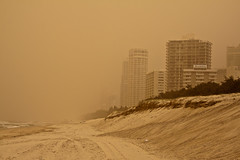
- Image by Michael Dawes via Flickr
It is tempting to think the dust storm that enveloped eastern Australia last month — choking Sydney with an estimated 5,000 tons of orange dust — is an anomalous event, the result of a decade-long drought. There is solid evidence that the number of dust storms is on the rise and a strong possibility that they may become more common as climate change advances.
On the global scale of dust storms, the one in Australia was modest — the big ones, in the Sahara and northern China, can throw hundreds of thousands of tons into the atmosphere. Seen from space, they look like — and are — entire weather systems, cyclones of particulates following the prevailing winds.
For the most part, these storms are the result of human activity: capturing dust liberated by poor agricultural practices, loss of native ground cover and deforestation. Scientists are only beginning to understand their many, complex effects. Saharan dust may help nourish the upper canopies of South American rainforest. And dust blown from China out over the Pacific Ocean tends to provide the micronutrients — especially iron — needed to cause phytoplankton blooms, which ultimately remove some carbon from the atmosphere.
Related articles by Zemanta
- Australia hit by worst dust storms in 40 years (cbc.ca)
- Dust Storm Video: Dust Storm Turns Sky Black In Broken Hill, Australia (VIDEO) (huffingtonpost.com)
- This is why you don’t drive in a dust storm [Video] (jalopnik.com)
- Another Dust Storm Hits Phoenix (shoppingblog.com)
- Giant dust storms turn Arizona highways into ‘war-zone’ multiple car pile-ups, 1 dead (theextinctionprotocol.wordpress.com)









